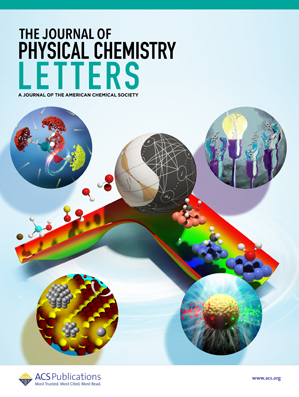含不同尺寸缺陷的PbSe和介质熵热电PbSe0.5Te0.25S0.25中的声子散射和热输运
IF 4.8
2区 化学
Q2 CHEMISTRY, PHYSICAL
引用次数: 0
摘要
缺陷工程已被证明是通过调整晶格热导率来优化热电性能的有效方法。了解不同尺寸缺陷对载热声子的作用是至关重要的。在这项研究中,我们利用机器学习原子间势研究了不同缺陷的PbSe和介质熵PbSe0.5Te0.25S0.25的晶格动力学和热输运性质。我们发现,引入3%的Pb空位使PbSe的晶格热导率(kL)降低了约40%,类似于位错(密度为2 × 1016 m-2)和纳米晶粒(晶粒尺寸为4000 nm3)。空穴增强声子在0.5 THz以上频率的散射,而位错、层错和晶界主要阻碍声子在1.5 THz以下的传播。相比之下,在PbSe0.5Te0.25S0.25中,由于本征熵引起的高频声子散射,空位对热输输抑制的影响较弱;高维缺陷,如晶界、层错和位错,通过增强频率低于1太赫兹的声子散射,可以更有效地降低kL。本研究揭示了缺陷影响晶格热导率的机制,为优化熵工程系统中的热输运提供了有价值的指导。本文章由计算机程序翻译,如有差异,请以英文原文为准。

Phonon Scattering and Thermal Transport in PbSe and Medium Entropy Thermoelectric PbSe0.5Te0.25S0.25 with Defects of Different Dimensions
Defect engineering has been proven to be effective in optimizing the thermoelectric performance by tailoring the lattice thermal conductivity. Understanding the roles of defects with different dimensions on heat-carrying phonons is crucial. In this study, we investigated the lattice dynamics and thermal transport properties of PbSe and medium entropy PbSe0.5Te0.25S0.25 with different defects, using a machine learning interatomic potential. We find that the introduction of 3% Pb vacancies reduces lattice thermal conductivity (kL) of PbSe by approximately 40%, similar to dislocations (with a density of 2 × 1016 m–2) and nanograins (grain size of 4000 nm3). Vacancies enhance phonon scattering at frequencies above 0.5 THz, whereas dislocations, stacking faults, and grain boundaries primarily hinder phonon propagation below 1.5 THz. In contrast, in PbSe0.5Te0.25S0.25, vacancies have weaker effects on thermal transport suppression due to the intrinsic entropy-induced high-frequency phonon scattering; higher-dimensional defects, such as grain boundaries, stacking faults, and dislocations, are more effective for reducing kL by enhancing phonon scattering at frequencies lower than 1 THz. This study reveals the mechanisms by which defects influence lattice thermal conductivity and provides valuable guidance for optimizing the thermal transport in entropy engineered systems.
求助全文
通过发布文献求助,成功后即可免费获取论文全文。
去求助
来源期刊

The Journal of Physical Chemistry Letters
CHEMISTRY, PHYSICAL-NANOSCIENCE & NANOTECHNOLOGY
CiteScore
9.60
自引率
7.00%
发文量
1519
审稿时长
1.6 months
期刊介绍:
The Journal of Physical Chemistry (JPC) Letters is devoted to reporting new and original experimental and theoretical basic research of interest to physical chemists, biophysical chemists, chemical physicists, physicists, material scientists, and engineers. An important criterion for acceptance is that the paper reports a significant scientific advance and/or physical insight such that rapid publication is essential. Two issues of JPC Letters are published each month.
 求助内容:
求助内容: 应助结果提醒方式:
应助结果提醒方式:


